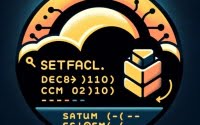Linux ‘strace’ Command | Installation and Usage Guide

Are you grappling with debugging your Linux processes? The ‘strace’ command, akin to a detective, can assist you in tracing system calls and signals in your Linux system. For many, particularly those new to Linux, the installation and usage of such commands might seem daunting. Yet, mastering ‘strace’ is a valuable skill worth acquiring. It’s accessible on most package management systems, simplifying the installation once you understand the process.
In this guide, we will navigate the process of installing ‘strace’ on your Linux system. We are going to provide you with installation instructions for Debian, Ubuntu, CentOS, and AlmaLinux, delve into how to compile ‘strace’ from the source, and install a specific version. Finally, we will show you how to use the ‘strace’ command and ascertain that the correctly installed version is in use.
Let’s get started with the step-by-step ‘strace’ installation on your Linux system!
TL;DR: How Do I Install and Use the ‘strace’ Command in Linux?
The
'strace'command is usually pre-installed on most Linux distributions. However, if it’s not, you can install it on Debian-based distributions like Ubuntu with the commandsudo apt-get install strace. For RPM-based distributions like CentOS, use the commandsudo yum install strace.
# For Debian-based distributions like Ubuntu
sudo apt-get install strace
# For RPM-based distributions like CentOS
sudo yum install strace
# Output:
# Reading package lists... Done
# Building dependency tree
# Reading state information... Done
# The following NEW packages will be installed:
# strace
# 0 upgraded, 1 newly installed, 0 to remove and 0 not upgraded.
# Need to get 0 B/524 kB of archives.
# After this operation, 1,577 kB of additional disk space will be used.
# Selecting previously unselected package strace.
# (Reading database ... 160975 files and directories currently installed.)
# Preparing to unpack .../strace_4.26-0.2_amd64.deb ...
# Unpacking strace (4.26-0.2) ...
# Setting up strace (4.26-0.2) ...
# Processing triggers for man-db (2.8.3-2ubuntu0.1) ...
This is just a basic way to install the ‘strace’ command in Linux, but there’s much more to learn about installing and using ‘strace’. Continue reading for more detailed information and advanced usage scenarios.
Table of Contents
- Understanding and Installing the ‘strace’ Command
- Installing ‘strace’ from Source Code
- Installing Different Versions of ‘strace’
- Basic Usage of ‘strace’
- Diving into Alternatives: ‘ltrace’ and ‘perf’
- Troubleshooting ‘strace’: Common Issues and Solutions
- System Call Tracking in Linux: A Deep Dive
- System Call Tracking: Its Impact on System Administration and Security
- Wrapping Up: Installing the ‘strace’ Command in Linux
Understanding and Installing the ‘strace’ Command
The ‘strace’ command is a powerful tool used in Linux for troubleshooting and debugging. It helps you trace system calls and signals in your Linux system, making it easier to understand what’s happening under the hood when a process is running.
Installing ‘strace’ with apt
If you’re using a Debian-based distribution like Ubuntu, you can install ‘strace’ using the apt package manager. Here’s how you do it:
sudo apt update
sudo apt install strace
# Output:
# Reading package lists... Done
# Building dependency tree
# Reading state information... Done
# The following NEW packages will be installed:
# strace
# 0 upgraded, 1 newly installed, 0 to remove and 0 not upgraded.
# Need to get 0 B/524 kB of archives.
# After this operation, 1,577 kB of additional disk space will be used.
The first command updates your package lists to ensure you’re installing the latest version of ‘strace’. The second command installs ‘strace’. The output shows that the ‘strace’ package is being installed.
Installing ‘strace’ with yum
If you’re using an RPM-based distribution like CentOS, you can install ‘strace’ using the yum package manager. Here’s how:
sudo yum update
sudo yum install strace
# Output:
# Loaded plugins: fastestmirror
# Loading mirror speeds from cached hostfile
# Resolving Dependencies
# --> Running transaction check
# ---> Package strace.x86_64 0:4.24-6.el7 will be installed
# --> Finished Dependency Resolution
# Installed:
# strace.x86_64 0:4.24-6.el7
# Complete!
Similar to the apt commands, the first command updates your package lists, and the second command installs ‘strace’. The output shows that the ‘strace’ package is being installed.
Installing ‘strace’ with pacman
If you’re using an Arch-based distribution like Manjaro, you can install ‘strace’ using the pacman package manager. Here’s how:
sudo pacman -Syu
sudo pacman -S strace
# Output:
# resolving dependencies...
# looking for conflicting packages...
# Packages (1) strace-5.14-1
# Total Installed Size: 1.46 MiB
# :: Proceed with installation? [Y/n] Y
# checking keyring...
# checking package integrity...
# loading package files...
# checking for file conflicts...
# checking available disk space...
# :: Processing package changes...
# installing strace...
# :: Running post-transaction hooks...
# Arming ConditionNeedsUpdate...
The first command updates your system and all installed packages, and the second command installs ‘strace’. The output shows that the ‘strace’ package is being installed.
Installing ‘strace’ from Source Code
For those who prefer to compile from source, here’s how you can do it:
# First, download the source code
wget 'https://github.com/strace/strace/releases/download/v5.14/strace-5.14.tar.xz'
# Extract the tarball
tar -xvf strace-5.14.tar.xz
# Move into the strace directory
cd strace-5.14
# Configure the source
./configure
# Compile the source
make
# Install strace
sudo make install
# Output:
# make[2]: Entering directory '/home/user/strace-5.14'
# /bin/mkdir -p '/usr/local/bin'
# /bin/sh ./libtool --mode=install /usr/bin/install -c strace '/usr/local/bin'
# make[2]: Nothing to be done for 'install-data-am'.
# make[2]: Leaving directory '/home/user/strace-5.14'
This set of commands downloads the source code, extracts it, configures the source, compiles it, and finally installs ‘strace’.
Installing Different Versions of ‘strace’
Installing from Source
The process is similar to the above, but you’ll need to change the version number in the URL to the version you want.
Using Package Managers
Using apt
# Install a specific version of strace
sudo apt install strace=4.26-0.2
Using yum
# Install a specific version of strace
sudo yum install strace-4.24-6.el7
Key Changes in Versions
Different versions of ‘strace’ can come with different features or compatibility. For instance, version 4.26 introduced improved support for decoding of netlink attributes, while version 4.24 improved the handling of interrupted syscalls.
| Version | Key Changes |
|---|---|
| 4.26 | Improved support for decoding of netlink attributes |
| 4.24 | Improved handling of interrupted syscalls |
Basic Usage of ‘strace’
How to Use ‘strace’
Here’s a simple example of using ‘strace’ to trace system calls:
# Trace system calls of the ls command
strace ls
# Output:
# execve("/bin/ls", ["ls"], 0x7ffc8b6e9a10 /* 51 vars */) = 0
# brk(NULL) = 0x55e1b1a2d000
# ...
This command traces the system calls made by the ‘ls’ command.
Verifying ‘strace’ Installation
You can verify that ‘strace’ is installed correctly by checking its version:
# Check strace version
strace -V
# Output:
# strace -- version 5.14
This command outputs the version of ‘strace’ that’s installed on your system, confirming that it’s installed correctly.
Diving into Alternatives: ‘ltrace’ and ‘perf’
While ‘strace’ is a powerful tool for tracing system calls, there are alternative methods for tracking system calls in Linux. Let’s explore two of these: the ‘ltrace’ command and the ‘perf’ tool.
Unveiling Library Calls with ‘ltrace’
The ‘ltrace’ command is similar to ‘strace’, but it traces library calls instead of system calls. Here’s how you can use it:
# Trace library calls of the ls command
ltrace ls
# Output:
# __libc_start_main(0x55a3c2d6d690, 1, 0x7ffe8b8b1f78, 0x55a3c2d6e700 <unfinished ...>
# setlocale(6, "") = "en_US.UTF-8"
# bindtextdomain("coreutils", "/usr/share/locale") = "/usr/share/locale"
# textdomain("coreutils") = "coreutils"
# __cxa_atexit(0x55a3c2d6d3a0, 0, 0, 0x7ffe8b8b1f48, 0 <unfinished ...>
# ...
This command traces the library calls made by the ‘ls’ command. It’s useful when you want to understand the library dependencies of a process.
Monitoring with ‘perf’
The ‘perf’ tool is a powerful performance analyzing tool in Linux. It can record CPU performance counters, tracepoints, kprobes, and more.
Here’s an example of using ‘perf’ to monitor the CPU usage of a process:
# Monitor CPU usage of the ls command
perf stat ls
# Output:
# Performance counter stats for 'ls':
# 0.001086 task-clock:u (msec) # 0.065 CPUs utilized
# 0.000000 context-switches:u # 0.000 K/sec
# 0.000000 cpu-migrations:u # 0.000 K/sec
# 0.000000 page-faults:u # 0.000 K/sec
# 0.001086 seconds time elapsed
This command records the CPU usage of the ‘ls’ command. It’s useful when you want to monitor the performance of a process.
| Tool | Advantages | Disadvantages |
|---|---|---|
| ltrace | Traces library calls, which can reveal more about a process’s behavior | Can be slower than ‘strace’ due to the overhead of tracing library calls |
| perf | Can monitor a wide range of system performance metrics | Can be complex to use due to the number of options and features |
While ‘strace’ is a great tool for tracing system calls, ‘ltrace’ and ‘perf’ offer additional capabilities that can be useful in different scenarios. Depending on your needs, you might find one tool more suitable than the others.
Troubleshooting ‘strace’: Common Issues and Solutions
While using ‘strace’, you may encounter certain issues. Let’s discuss some common problems and how to resolve them.
Problem: Permission Denied
When you try to trace a process owned by another user or system, you might encounter a ‘Permission denied’ error. This is a security feature of Linux to prevent unauthorized access to processes.
sudo strace -p 1234
# Output:
# strace: attach: ptrace(PTRACE_ATTACH, ...): Permission denied
In this case, the solution is to run ‘strace’ with sudo privileges.
sudo strace -p 1234
# Output:
# strace: Process 1234 attached
# ...
Problem: ‘strace’ Command Not Found
If you haven’t installed ‘strace’ or if it’s not in your PATH, you might encounter a ‘command not found’ error.
strace ls
# Output:
# bash: strace: command not found
The solution is to install ‘strace’ if it’s not installed, or add it to your PATH if it’s not there.
Problem: ‘strace’ Output is Too Verbose
‘strace’ can produce a lot of output, which can be overwhelming. Here’s how you can limit the output to only the system calls you’re interested in:
# Trace only open, read, and write system calls
strace -e trace=open,read,write ls
# Output:
# openat(AT_FDCWD, ".", O_RDONLY|O_NONBLOCK|O_CLOEXEC|O_DIRECTORY) = 3
# getdents(3, /* 3 entries */, 32768) = 72
# getdents(3, /* 0 entries */, 32768) = 0
# close(3) = 0
This command traces only the ‘open’, ‘read’, and ‘write’ system calls made by the ‘ls’ command, reducing the amount of output.
By understanding these common issues and their solutions, you can use ‘strace’ more effectively and troubleshoot problems more efficiently.
System Call Tracking in Linux: A Deep Dive
To fully grasp the ‘strace’ command, it’s crucial to understand the concept of system call tracking in Linux. A system call is the primary method used by a program to request a service from the kernel. These services include creating a process, reading from a file, writing to a file, and more.
Why System Call Tracking is Important
System call tracking is a vital part of debugging and performance optimization. By examining the system calls made by a program, you can identify what the program is doing, detect any unusual behavior, and find ways to optimize its performance.
For example, if a program is running slower than expected, you might use ‘strace’ to trace its system calls and discover that it’s making a large number of read or write calls. This could indicate that the program is reading or writing data in small chunks, which can be inefficient. By modifying the program to read or write data in larger chunks, you could significantly improve its performance.
# Trace system calls with strace
strace -c ls
# Output:
# % time seconds usecs/call calls errors syscall
# ------ ----------- ----------- --------- --------- ----------------
# 59.38 0.000457 4 121 read
# 40.62 0.000312 6 52 write
# 0.00 0.000000 0 10 open
# 0.00 0.000000 0 13 close
# 0.00 0.000000 0 10 fstat
# 0.00 0.000000 0 23 mmap
# 0.00 0.000000 0 17 mprotect
# 0.00 0.000000 0 2 munmap
# 0.00 0.000000 0 3 brk
# 0.00 0.000000 0 2 rt_sigaction
# 0.00 0.000000 0 1 rt_sigprocmask
# 0.00 0.000000 0 1 ioctl
# 0.00 0.000000 0 4 pread64
# 0.00 0.000000 0 1 access
# 0.00 0.000000 0 1 execve
# 0.00 0.000000 0 2 getdents
# 0.00 0.000000 0 1 statfs
# 0.00 0.000000 0 1 arch_prctl
# 0.00 0.000000 0 1 set_tid_address
# 0.00 0.000000 0 1 set_robust_list
# ------ ----------- ----------- --------- --------- ----------------
# 100.00 0.000769 268 total
The above ‘strace’ command traces the system calls made by the ‘ls’ command and outputs a summary of the system calls made. The output shows that the ‘ls’ command made a total of 268 system calls, with the ‘read’ and ‘write’ system calls taking up the most time.
Understanding system call tracking can be a game-changer when it comes to debugging and optimizing programs in Linux. The ‘strace’ command is a powerful tool for this purpose, offering a window into the interactions between your programs and the Linux kernel.
System Call Tracking: Its Impact on System Administration and Security
Understanding system calls and their tracking is not just a debugging exercise but also a crucial aspect of system administration and security. It provides insights into the behavior of processes, helping administrators manage system resources effectively.
Signal Handling in Linux
Signal handling is another essential concept in Linux. Signals are software interrupts sent to a program to indicate that an important event has occurred. The events can vary from user requests to illegal memory access errors. Some common signals are SIGINT, SIGQUIT, and SIGKILL.
# Example of sending a SIGINT signal to a process
kill -SIGINT 1234
# Output:
# (no output, but the process with PID 1234 is interrupted)
In this example, we’re sending a SIGINT signal to the process with PID 1234. This signal interrupts the process, similar to pressing Ctrl+C in the terminal.
Process Management in Linux
Process management is a fundamental part of Linux system administration. It involves starting, stopping, and monitoring processes. Tools like ‘top’, ‘ps’, and ‘htop’ are commonly used for process management.
# Example of using the top command to monitor processes
top
# Output:
# top - 18:25:01 up 7:18, 1 user, load average: 0.00, 0.00, 0.00
# Tasks: 97 total, 1 running, 96 sleeping, 0 stopped, 0 zombie
# %Cpu(s): 0.3 us, 0.0 sy, 0.0 ni, 99.7 id, 0.0 wa, 0.0 hi, 0.0 si, 0.0 st
# MiB Mem : 1987.0 total, 1123.3 free, 216.5 used, 647.2 buff/cache
# MiB Swap: 1024.0 total, 1024.0 free, 0.0 used. 1558.8 avail Mem
# ...
The ‘top’ command provides a dynamic real-time view of the running system. It displays system summary information and a list of processes currently being managed by the Linux kernel.
Understanding these concepts can provide a deeper insight into how Linux operates and help you become a more effective system administrator.
Further Resources for ‘strace’ and System Call Tracking Mastery
For those looking to delve deeper into the world of system call tracking and ‘strace’, here are some resources:
- The Art of Debugging – A comprehensive guide to debugging with various tools.
Linux System Programming: Talking Directly to the Kernel and C Library – This book provides a deep dive into Linux system programming, including system calls and signal handling.
The Linux Programming Interface – A detailed guide to Linux and UNIX system programming, including process management and system call tracking.
Wrapping Up: Installing the ‘strace’ Command in Linux
In this comprehensive guide, we’ve explored the installation and usage of the ‘strace’ command in Linux, a powerful tool for tracing system calls and signals. This command is a valuable asset for system administrators and programmers, enhancing system monitoring and debugging.
We started with the basics, learning how to install ‘strace’ using different package managers depending on the Linux distribution. We then delved into more advanced topics, such as installing ‘strace’ from source code, installing different versions, and verifying the installation. We also provided a basic usage guide and discussed more advanced usage scenarios.
Along the way, we tackled common issues that you might encounter when using ‘strace’, such as ‘Permission denied’ and ‘command not found’ errors, providing you with solutions for each issue. We also looked at alternative methods for tracing system calls, like using the ‘ltrace’ command and the ‘perf’ tool, giving you a sense of the broader landscape of tools for system call tracking.
| Tool | Pros | Cons |
|---|---|---|
| strace | Powerful tool for tracing system calls | Can produce verbose output |
| ltrace | Traces library calls, revealing more about a process’s behavior | Can be slower than ‘strace’ due to the overhead of tracing library calls |
| perf | Can monitor a wide range of system performance metrics | Can be complex to use due to the number of options and features |
Whether you’re just starting out with ‘strace’ or you’re looking to level up your system administration skills, we hope this guide has given you a deeper understanding of ‘strace’ and its capabilities.
With its ability to trace system calls and signals, ‘strace’ is a powerful tool for debugging and performance optimization in Linux. Now that you’re equipped with this knowledge, you’re ready to tackle system administration tasks more effectively. Happy coding!


